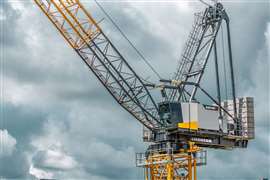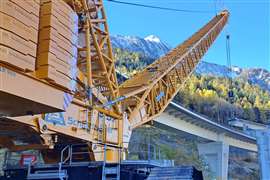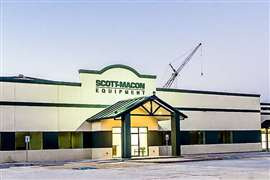Number crunching: batteries and tower cranes
30 September 2024
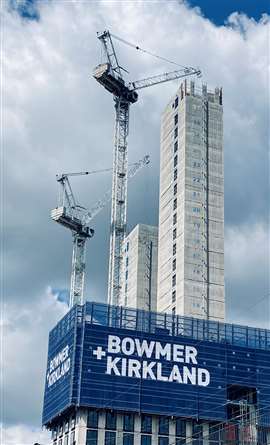 Construction of the Echo Street student accommodation blocks in Manchester, England. Two Terex CTL 180 luffing jib tower cranes are largely powered by Enertainer battery energy storage system – saving money and carbon at the same time. Photo: Bowmer and Kirkland
Construction of the Echo Street student accommodation blocks in Manchester, England. Two Terex CTL 180 luffing jib tower cranes are largely powered by Enertainer battery energy storage system – saving money and carbon at the same time. Photo: Bowmer and Kirkland
Using batteries instead of diesel generators to help power construction sites, and tower cranes in particular, is a hot topic.
Construction contractor Bowmer & Kirkland in the UK has already gone as far as adopting battery energy storage systems as its preferred method for powering cranes. In fact, it has learnt that entire sites can be powered by a single battery.
On a £130 million (US$170 million) contract in Manchester, northern England, Bowmer & Kirkland is using an Enertainer L+ battery energy storage system to power two Terex CTL 180 luffing jib tower cranes, two twin hoists and currently 11 – but at peak will be 33 – mast-climbing work platforms (MCWPs). The battery is also powering site offices, lighting and anything else that needs electricity.
The contract is for the construction of a purpose-built student accommodation complex in Echo Street. The development comprises three connected tower blocks of 27, 21 and 16 storeys – 38,350 square metres in all, to provide accommodation for 1,224 students in the city centre.
Bowmer & Kirkland started work in October 2023 and is scheduled to complete in July 2026.
Traditionally, of course, diesel generators would be used to power machinery on such a project but contractors in the UK have been forced to rethink their methods. This is not just about embellishing their ecological credentials; in April 2022 the tax relief the construction industry previously enjoyed for diesel was scrapped. This made the cost of diesel suddenly two or three times greater (depending on market price oscillations).
That extent to which batteries have proved to be an effective replacement for diesel generators has surprised many.
The Enertainer L+ battery system in use on Echo Street is produced by Hong Kong-based Ampd Energy. (Enertainer is derived from energy and container). Tom Carter is Ampd business development manager in the UK. He previously worked for Bowmer & Kirkland for 11 years before joining Ampd in July this year.
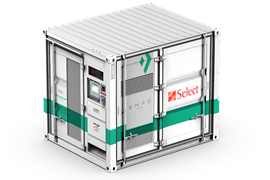 The Ampd Enertainer battery unit with built in charging and monitoring equipment. Photo: Select Plant
The Ampd Enertainer battery unit with built in charging and monitoring equipment. Photo: Select Plant
Doing the numbers
Carter explains that the crane specification for Echo Street required a 300 kVA generator for each crane, to provide 420 Amps at peak, in the event that all motors might need to work simultaneously – even though in the real world cranes hardly ever hoist, slew and luff at the same time.
Had Bowmer & Kirkland gone down the traditional route of diesel generator sets, it would have needed two 300 kVA generators for the cranes, two 100 kVA gensets for the hoists and three 200 kVA gensets for the MCWPs. All told, it would have needed a thirsty 1,660 kVA of diesel generator capacity.
It has replaced all of this with one big battery, on hire from Select Plant since November 2023, putting 2,500 kW into the site each week.
Plugged into a standard electrical socket in a neighbouring building, with a trickle charge of 44 Amps, the Enertainer provides 663 Amps per minute nominal current and 795 A/min overload.
The Enertainer is constantly charging. How much it draws down from the grid depends on the activity of the machinery on site. It has not yet gone down below 53 per cent capacity. Each morning it is back up to around 95 %.
Cleaning up
Carter says a conventional diesel-powered 1,660 kVA genset would emit 999 tonnes of carbon dioxide a year. “We are removing 913 tonnes of this with the Enertainer,” he says.
This figure is based on a 0.02 kg industrial norm for measuring electricity’s carbon footprint – its actual footprint depends on how the electricity was generated in the first place.
If Echo Street was run on diesel generators and they running on 50 % uptime, they would consume 150 litres of diesel per hour – or 429,000 litres a year.
By the most conservative estimate, therefore, if we assume two years for the construction phase and nine months for fit-out and commissioning, the Enertainer L+ is saving Bowmer & Kirkland more than a million litres of fuel at Echo Street.
Carter won’t disclose the full financial details but we can work some of them out. A million litres of unsubsidised diesel would cost in the region of £1.4 to £1.5 million. Even with recent changes the electricity bill can realistically be calculated at around £50,000 a year while the cranes, hoists and mast climbers are all in action, or £100,000 for the two-year build phase. That’s a significant financial saving, even when the (undisclosed) cost of renting the Enertainer is factored in.
Of course, there are many construction sites that cannot just plug into mains electricity.
If operating off-grid, the Enertainer can be charged with a 60 to 100 kVA generator, Carter says. The generator is set to fire up when the battery gets below a specified threshold and recharge it. According to Carter, on a site the scale of Echo Street, this would deliver a 60 % carbon saving rather than the 91 % carbon saving being achieved by plugging into the mains.
Further advantage
There is another benefit to batteries too. Bowmer & Kirkland previously used batteries instead of diesel generators on a £300 million residential development of 17 and 19 floors in the West Bar district of Sheffield in the north of England. Now reaching completion, this is believed to have been the first major construction site in the UK to be fuelled solely by battery, although here the battery was supported by a Dumarey Peak Power (formerly Punch Power) flywheel system to meet spikes in energy demand. On West Bar, the permanent power supply was late arriving, which threatened to delay the commissioning process. It is not technically feasible to use a generator to commission a building but the battery system proved to be perfectly up to the task and was used to commission five floors of the development.
Bowmer & Kirkland turns over £1.2 billion (US$1.6 billion) a year. Despite its size, it prefers to hire its machinery, rather than own it directly. But it is so sold on the battery concept for power its sites that not only has it made it company policy to use batteries wherever feasible – it had 11 on its various sites at one time – it has now started buying its own, with two Entertainers on order.


